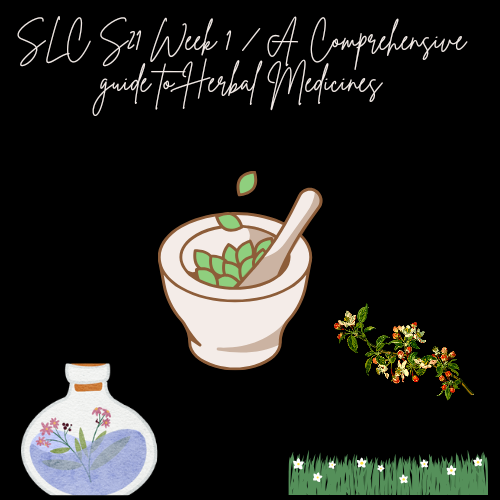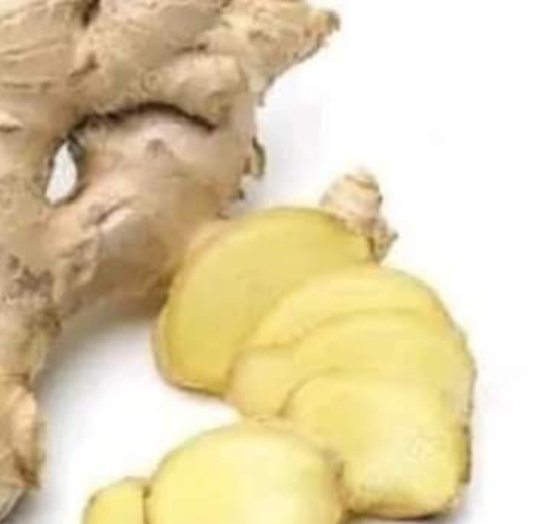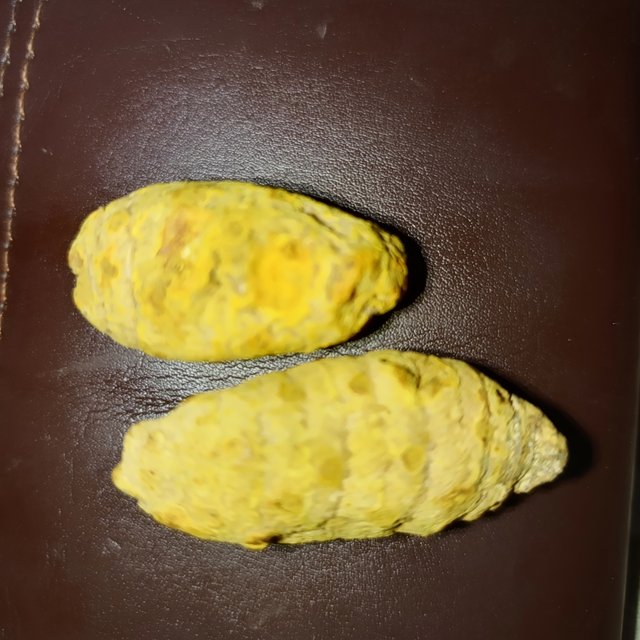SLC S21 Week 1 / A Comprehensive guide to Herbal Medicines
Greetings,

Research Assignment: Research and write a history of herbal medicine in your culture or region.
The use of herbal medicine in South Asia characterized by antiquity that goes for thousand years with the strong component of culture and spiritual beliefs. Others include the ancient Indian system of medicine called Ayurveda and the Unani system of medicine introduced by Arab and Persian scholar in India. These systems are based on the principle that the human body contains five elements and that circulation of energy or Qi will lead to a healthy state.
Ayurveda, which is considered to be more than 5000 years old, employs herbs like turmeric ginger and Ashwagandha overcoming illnesses, building immunity and wellness. Some of the available ancient literature like Charaka Samhita, Sushruta Samhita describes the numerous herbs along with their properties scientifically. The Ayurveda system, which comes later, follows similar concepts and concerns itself with temperaments and balance; the mint, licorice and aloe being the most important.
In Pakistan people frequently use the so called hikmat or tib-e-Unani which dealing with herbal medicine. There are indigenous herbs such as neem, basil, and fennel all of which form the basis of remedies for respiratory illnesses, digestive disorders and skin diseases respectively. Herbal practices are usually considered as generation practices and still are in practice though most of them can be adopted mostly in the rural areas where they easily access modern health facilities.
Today, however, there is an increase in the use of herbal medicine because it is believed to be back in times with the principles of wellness practices. They go on proving how much DM is still relevant and capable in preserving culture while at the same time pursuing the promotion of natural means.
Comparison Task: Create a table comparing the benefits and side effects of modern medicines vs. herbal medicines for common ailments (e.g., cold, headache).
| Aspect | Modern Medicines | Herbal Medicines |
|---|---|---|
| Effectiveness | fast acting with precise dosages | slower acting effects build over time |
| --- | --- | --- |
| Benefits | Fast-acting relief | Natural ingredients and synthetic ingredients |
| --- | --- | --- |
| Common elements Treated | cold headache fever infection | cold digestive issues |
| --- | --- | --- |
| Side effects | Adverse effects such as drowsiness etc | Effects of diet and its limited research etc |
| --- | --- | --- |
| Risk of dependency | certain medicines (e.g painkillers ) | generally low risk of dependency |
Summary: Soneria or rapid relief may be obtained from modern medicines as well as fine adjustment of doses but these medicines have potential side effect and drug dependence. Traditional medicines are appreciated due to their natural ingredients and the involvement of the entire organism but are generally slower and if improperly used some side effects.
Herb Identification: Choose 3 herbs from your kitchen like mint, ginger, or turmeric and list their health benefits. Mention the recipes where you have used these herbs.
Below are three familiar herbs frequently used in most households, the health benefits of, and recipes I have employed them in; they include mint herb, ginger, and turmeric.
- Mint: Mint is one of the best herbs which is very much used in our daily lives due to its ability to produce a cool feeling especially when taken during hot weather. It assists in digestion, approved in the treatment of head aches, also curing respiratory illnesses. Being a good source of antioxidants, it enhances immunity. I do like to use mint in homemade lemonade where it adds a wonderful cooling sensation to the drink. It is also used in making a change to the regular raita, which is prepared from yogurt and is best served with spicy foods.

- Ginger: Ginger is highly rated in the market mainly due to its healing qualities. It acts as an anti-inflammatory agent, aids in digestion and helps to bring relief to nausea and muscular pain. Also, it has potent antioxidants that may help reduce damage to cells. The simplest food that I prepare with ginger is ginger tea which is suitable for sufferers of cold or sore throat. It eventually forms the base for curries or stews as is seen in the preparation of the chicken curry where the spice gives the food a warm background spice.

- Turmeric: Curcumin a natural ingredient found in Turmeric is a yellow natural hue with anti-inflammatory and antioxidant effects. It is used in treating and preventing heart diseases, helps the body become less susceptible to diseases, and that it can actually beautify skin. I use turmeric in preparation of cakes and add it to vegetable soup and lentil soup for its taste and health wise. Another great use of coconut oil is in golden milk, a drink made from turmeric, milk, and honey that is perfect for someone with a weak immune system.

The herbs taste unique and have healing qualities that I can’t do without them in the kitchen or have as a backup.
- Ginger Recipe
Ginger, which has a warm, spicy taste, gives a zest to many kinds of preparations. It includes components such as gingerol, which has strong antioxidant and anti inflaming properties, usage in digestion as well as in the curing of nausea. Young ginger is typically used to add its flavour into other meals besides being used to prepare beverages, including soups and stews, ginger snaps and other foods. Also, it’s used regularly in marinades for softening and intensifying of tastes of meat products. As a ginger fix, you can chop ginger into slices and boil them in water to make a warm water ginger tea for a sore throat remedy, and increase your body’s immunity.
- Turmeric Recipe
Curcurmin is gotten from the roots of the plant and this spice gets its yellow color from the chemical compound called curcurmin which has many health benefits due its anti-inflammatory properties. It is extensively used in Indian cuisine as an accompaniment that colours curries, rice dishes, and sauces slightly and adds extra taste. Curcumin may be best combined with black pepper, which enhances its absorption by the body. In terms of preparation, curcumin is best ingested dissolved in fats, which is why turmeric milk or “golden milk” has gained wide popularity. Try boiling turmeric in milk and adding a pinch of cracked black pepper, for a very mild immune tonic and a brew good for the joints.
- Mint Recipe
Mint is a fresh-acting, green herb that has a refreshing feel on the tongue and is used in fruit and savory dishes. Due to these properties, it may enhance the taste of cocktails, enhance the salad or give softness to the desert. It also has some other ingredients such as menthol that will give you that cool feel on your tongue and is good for digestion. They are usually used fresh including in the making of smoothies, in drinks like the mojito and as garnishing on different foods. Another preparation method is mint tea in which fresh leaves are allowed to steep in boiling water and this type of mint helps sooth upset stomachs and produce a relaxing effect on the rest of the body.
- Ginger-Turmeric Mint Tea Recipe:
This tea offers the heating ability of ginger, the complexion of turmeric, besides the coolness of mint you experience an incredibly surging and comforting mix. To prepare it, adding one cup water and one teaspoon freshly grated ginger and turmeric is enough. Everyone should let it simmer, let it sit for approximately 5 minutes before adding a few sprigs of fresh mint. Meanwhile, steep it for another minute before putting a strainer on to separate solid components from the beverage. This tea is a great choice if you are in for a cup during cold weather and has anti-inflammatory and immune-supportive benefits. pot, add honey for sweetener depending on the particular preference. It is a solution probably as nature’s perfect drink that can help your digestive system, relieve inflammation and even help in keeping away the blues.
Forms of Herbs: Write about the different forms of the herbs.
Certainly! Here’s a detailed breakdown of different forms of herbs and their uses:
- Fresh Herbs
The garden fresh ingredients give your broth the right kind of flavour and aroma that is needed for the foods. Whole, chopped or crushed, they can be utilized to extract its natural oils. Most operation liabilities which can be fresh herbs such as fresh basil, fresh cilantro, fresh mint are used in salads, sauces, and marinades. They are often incorporated toward the finality of cooking to ensure that the tastes and vitamins are retained. Fresh herbs are also used for decoration purposes as garnishes. Sadly though, they are very short lived, and definitely require quick use or proper preservation for long as they wilt and lose all their glory.
- Fresh Herbs
- Dried Herbs
Dried herbs are fresh herbs which have been sundried or oven dried in order to retain their flavors and all the goodness. Including dry thyme, rosemary and dried oregano. It is preferred to grow them since the dried ones have a longer shelf life than the fresh ones in the market. Since dried herbs contain higher proportions of the active ingredients, they should, therefore, be applied sparingly. They are usually incorporated earlier during food preparation so as they can intermingling with other culinary ingredients. Dried herbs might not be as eye appealing as fresh herbs but they are essential when preparing soup, stew and sauces.
- Dried Herbs
- Ground Herbs
Dried herbs are finely powdered and referred to as ground herbs. They melt rather fast and assimilate freely with foods to impart intersectionate tastes. Whole spices, in particular, ground ginger and ground turmeric, are widely used by adding to spice mixtures and curry settings. These herbs are athe blade and may be easily incorporated into soups, marinades and baked products. It also applies to dry rubs for meats and poultry Ground herbs perform well in dry applications. However, they quickly lose their effectiveness as compared to whole dried herbs and should only be bought in small quantities to be stored in a cool dark area.
- Ground Herbs
- Herbal Extracts
Herbal extracts are defined as potent and potentiated material prepared by steeping the herbs in a solvent which is either alcohol or glycerin. Essential oils are obtained directly from plant material and are very strong and quick in their effects as compared to the whole herb. Examples include extracts of peppermint and vanilla etc. These are widely applied in cooking, baking, medicine, and perfumery products besides being applied in cosmetics. A few drops can enhance taste of foods or yield great health boosters for the body fitness regimes. Herbs should be applied moderately because they possess high contents and are usually incorporated at the final stage of preparation or in drinks.
- Herbal Extracts
- Herbal Oils
Herbal oils are oils made by steeping herbs in a base oil- olive, coconut or other vegetable oils so as to capture their flavors and properties. These oils are employed in cooking and as well in different aspects of pharmaceuticals. For instance, basil oil is best used to enrich dishes while lavender used in preparing skincare products. Herbal oils are quite unique: they can be eaten as when used to dress a salad, cooked in food, or used as a massage oil. They are also employed in aromatherapy. This is the reason why they require dark bottles to enable them be accurately stored in order to have a longer shelf life.
- Herbal Oils
- Herbal Tinctures
Herbal tinctures are liquid herbal preparations made by steeping the herbs in alcohol for some time, and it dissolve certain chemical compounds into the liquid. Examples of tinctures are those prepared from echinacea, valerian, and chamomile. Tinctures are convenient to administer, and the subject only requires a few drops for treatment, which may well be dropped in water. These types of supplements are well received in holistic and traditional medicines since they come in small packages but are very concentrated and have a long preservation duration. Tinctures can be consumed for years and perfect for individuals who are on the go or to add it to their drinks.
- Herbal Tinctures
- Herbal Capsules
Herbal capsules are processed plants in a simple capsule form by enclosing them in a dried or powdered form of a pill. Such capsules are known in the sphere of supplements and can be helpful to get herbs such as turmeric, garlic, and ginger into your diet. The use of capsules ensures that different herbal remedies have a fixed volume and also ensures that the bitter ingredients cannot be tasted. They are rather useful for individuals who seek to get a variety of therapeutic properties and don’t wish to add the herbs to recipes. But herbal capsules can be used according to dosage measurement and they are commonly used after consulting the health care provider.
- Herbal Capsules
- Herbal Teas
Herbal teas are beverages derived from brewing fresh or dried natural herbs in warm water. Examples of herb used in making teas are chamomile, peppermint and lemongrass. These teas have different effects on the body such as helping to aid digestion or to soothe. Herbal teas do not contain any caffeine and are, therefore, more relaxing than normal teas. They are best taken hot or cold with honey as the sweetner. They also work as a cure, for instance, you can take gingers tea when you have a cold, or chamomile tea when you have sleepless night. Warm brewing takes different durations depending on the used herb and this determines the strength of taste and concentration.
- Herbal Teas
Safety Report: Pick one herb and research any potential side effects and how to avoid them.
Safety Report on Ginger
Ginger is a well-known and widely grown plant best-restricted as the spice and medicine. However, it is mostly safe, and the following are the possible side effects of ginger: Below are possible side effects and information concerning how to take ginger appropriately.
Potential Side Effects
- Anti-platelet effect High concentrated ginger might cause digestive System side effects like heartburn, gas and bloating. That is why some people may develop nausea or even a burning feeling in the mouth and throat. These symptoms usually are not dangerous but the person may feel uneasy if he takes too much ginger in his diet.
- Risks of Thinning of Blood Ginger contains natural blood thinners. It is safe to consume in moderation but regular or large intake maybe associated with an increased risk of bleeding, particularly for people taking blood thinners such as warfarin, aspirin, or heparin. These bleeds can be of great importance in patients with bleeding disorders or ones that are undergoing surgery.
- On blood sugar and blood pressure Ginger has been observed to have the possible side effect of reducing blood sugar and blood pressure especially for patients on diabetic or hypertensive drugs. When taken together with those medicines, ginger could bring levels to borderline with side effects such as light headedness, tiredness, or even fainting spells.
Safe Use Recommendations
- Dosage Limit To prevent side effects, ginger should be consumed in moderate amounts and, best should not exceed a daily dosage of 4 grams. For pregnant women, their doctors recommend an even higher measure of safety precaution as such doses are said to cause increased bleeding risk, or stimulate uterine contractions.
- People taking anticoagulant medications, diabetic, experiencing high blood pressure or pregnant must first consult with their health care provider before introducing ginger supplements to their diets. Because ginger interacts with drugs and may cause side effects, moderating ginger consumption is beneficial.
When you make wise decisions about ginger and how to consume it, then it can only be for the better as you will benefit fully from the herb without having to suffer any of the drawbacks.
Hi, @niaz1,
Your post has been manually curated!